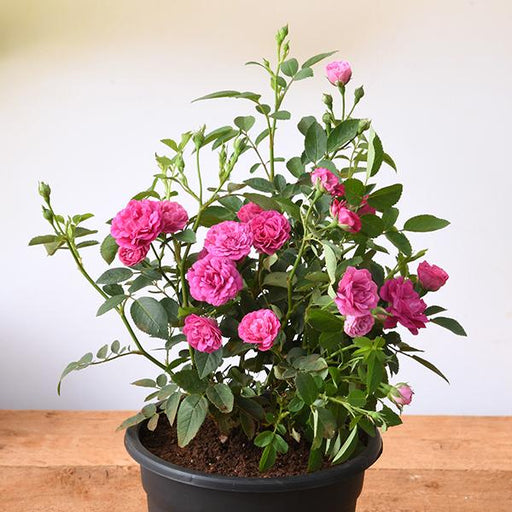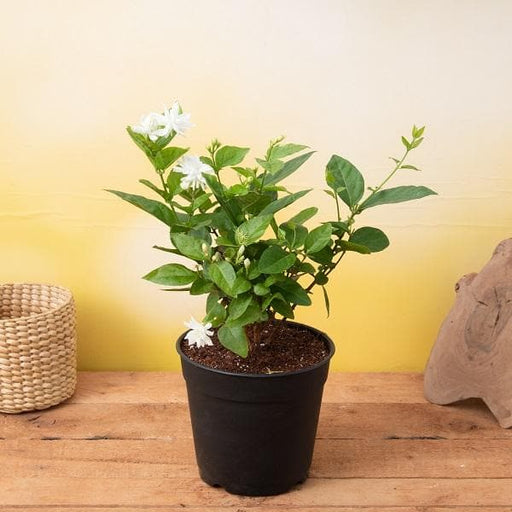
Spathodea Campanulata, Fountain Tree - Plant
(MRP Inclusive of all taxes)
- Shipping ₹79 for entire order
- Dispatch in 7 days
- Country of origin: India

(MRP Inclusive of all taxes)
 Save 29%
Save 29%
Air Purifier Money Plant with Pot The Air Purifier Money Plant, also known as Pothos or Epipremnum aureum, is a stunning indoor plant that...
View full details
 Save up to 15%
Save up to 15%
Peace Lily, Spathiphyllum - Plant The Peace Lily, scientifically known as Spathiphyllum, is a stunning houseplant celebrated for its elegant white...
View full details
 Save 25%
Save 25%
Jasminum sambac, Mogra, Arabian Jasmine - Plant Jasminum sambac, commonly known as Mogra or Arabian Jasmine, is a fragrant flowering plant...
View full details
 Save 18%
Save 18%
Combo Constituents Includes the Parijat Tree (Night-Flowering Jasmine), a culturally significant plant with fragrant flowers. Description The Pari...
View full details
 Save 25%
Save 25%
Miniature Rose, Button Rose (Any Color) - Plant The Miniature Rose, also known as the Button Rose, is a charming and compact flowering plant that ...
View full details Save 25%
Save 25%
Damascus Rose, Scented Rose (Any Color) - Plant The Damascus Rose, also known as Rosa damascena, is a timeless symbol of beauty and romanc...
View full details
 Save 17%
Save 17%
Beautiful Fragrant Mogra, Arabian Jasmine Plant with Pot The Beautiful Fragrant Mogra, also known as Arabian Jasmine (Jasminum sambac), is...
View full details Save 15%
Save 15%
Pack of Vermicompost and Neem Cake for House Plants Transform your indoor garden with our premium Pack of Vermicompost and Neem Cake, spec...
View full details
Pack of Plant Growth and Flower Boosters Unlock the full potential of your garden with our Pack of Plant Growth and Flower Boosters! This ...
View full details Save 38%
Save 38%
Combo of Jeevamrut and Neem Raksha for Easy Growth and Protection of Houseplants Transform your indoor garden with our exclusive combo of ...
View full details Save 22%
Save 22%
Plant Nutrients Kit (Pack of 16) for a Healthy Garden Transform your garden into a lush paradise with our Plant Nutrients Kit, featuring 1...
View full details Save 16%
Save 16%
Combo of Top Plant Fertilizers Elevate your gardening game with our exclusive Combo of Top Plant Fertilizers, featuring two bags of premiu...
View full details Save 24%
Save 24%
Pack of 4 Additives to Make Soil Healthy and Nutrient Rich Transform your garden into a thriving ecosystem with our Pack of 4 Additives de...
View full details Save 30%
Save 30%
Transform your gardening experience with our premium Combo of Perlite and Vermiculite. This unique blend is designed to enhance soil aeration and ...
View full details Save 27%
Save 27%
Combo of 2 Vermicompost and Cocopeat - Enrich Your Soil Naturally! Transform your garden into a thriving ecosystem with our Combo of 2 Ver...
View full details
 Save 35%
Save 35%
Best 6 Plants for Perfect Indoor Garden Transform your living space into a lush oasis with our curated collection of the Best 6 Plants for a...
View full details
 Save up to 50%
Save up to 50%
Mini Succulent Garden Pack Transform your space with our Mini Succulent Garden Pack, featuring a delightful collection of 4 any variety beautiful s...
View full details
 Save 30%
Save 30%
5 Best Fragrant Plants Transform your garden or indoor space into a fragrant paradise with our curated selection of the 5 Best Fragrant Plants. Th...
View full details
 Save 24%
Save 24%
Set of 2 Bonsai Looking Grafted Adeniums Transform your indoor or outdoor space with our exquisite Set of 2 Bonsai Looking Grafted Adenium...
View full details Save 45%
Save 45%
Top 4 Die Hard Succulents Pack Transform your indoor or outdoor space with our Top 4 Die Hard Succulents Pack, featuring a curated selecti...
View full details
 Save 30%
Save 30%
5 Best Indoor Plants Pack Transform your living space into a lush oasis with our '5 Best Indoor Plants Pack.' This carefully curated collection fe...
View full details
 Save 25%
Save 25%
Set of 4 Evergreen Air Purifier Plant Pack Transform your indoor space into a lush, green oasis with our Set of 4 Evergreen Air Purifier Pla...
View full details| SrNo | Item Name |
|---|---|
| 1 | Spathodea Campanulata, Fountain Tree - Plant |
The Spathodea Campanulata, commonly known as the Fountain Tree, is a stunning tropical tree native to Africa. Renowned for its vibrant, trumpet-shaped flowers that bloom in shades of orange and red, this tree can reach heights of up to 30 meters. Its lush, green foliage provides a beautiful contrast to its colorful blossoms, making it a popular choice for gardens and parks.
What sets the Fountain Tree apart is its ability to attract pollinators, including bees and hummingbirds, contributing to local biodiversity. This tree not only enhances the aesthetic appeal of any landscape but also plays a vital role in supporting wildlife. Its fast growth rate and resilience to various environmental conditions make it a favorite among gardeners and landscapers alike.
Special features of the Fountain Tree include its unique, bell-shaped flowers that can grow up to 10 cm in diameter, and its ability to thrive in a variety of soil types. Additionally, the tree's broad canopy provides ample shade, making it an excellent choice for creating cool, inviting outdoor spaces.
If you think caring for a Spathodea Campanulata is like raising a pet rock, think again! This beauty demands attention, sunlight, and a sprinkle of love. Water it regularly, but don’t drown it—this isn’t a swimming competition. Fertilize during the growing season, and watch it bloom like it’s auditioning for a floral Broadway show.
The Fountain Tree isn’t just a pretty face; it’s a multitasking marvel! It provides shade, attracts pollinators, and can even improve your property value. Imagine lounging under its vibrant canopy while sipping lemonade, feeling like royalty in your own backyard.
Fasten your seatbelts because the Fountain Tree grows like it’s in a race! In optimal conditions, it can reach heights of up to 50 feet in just a few years. Talk about a tree that doesn’t believe in taking its time!
Want to spread the love? Propagating Spathodea Campanulata is like playing matchmaker for plants. You can do it through seeds or cuttings, but remember, patience is key. It’s not a speed dating event; it’s a long-term commitment!
Every rose has its thorn, and every Fountain Tree has its pests. Watch out for aphids and scale insects trying to crash the party. A little neem oil can send them packing, ensuring your tree remains the belle of the botanical ball.
This tree is a bit of a diva when it comes to soil. It prefers well-draining, loamy soil that’s rich in organic matter. Think of it as the Goldilocks of plants—too dry or too wet, and it’ll throw a tantrum!
Get ready for a floral fiesta! The Fountain Tree bursts into bloom during the warm months, showcasing its trumpet-shaped flowers in vibrant hues. It’s like nature’s way of throwing a party, and everyone’s invited!
If you’re looking to jazz up your garden, the Fountain Tree is your go-to plant. Use it as a focal point, a shade provider, or even a backdrop for your garden parties. It’s the ultimate wingman for your outdoor space!
This tropical beauty thrives in warm climates, so if you live in a place where snow is a four-letter word, you’re in luck! It loves humidity and sunshine, making it the perfect plant for those who enjoy a little heat.
Known affectionately as the Fountain Tree or African Tulip Tree, this plant has a reputation that precedes it. It’s like the celebrity of the plant world, always turning heads and making a statement wherever it grows.
Fear not, plant lovers! The Fountain Tree is not toxic to pets or humans. So, you can enjoy its beauty without worrying about your furry friends turning into plant-eating monsters. It’s a win-win for everyone!
Beyond its stunning appearance, the Fountain Tree has practical uses too! Its wood is durable and can be used for furniture, while its flowers can be used in traditional medicine. Who knew a tree could be so versatile?
Spathodea Campanulata, also known as the Fountain Tree, is a tropical beauty with trumpet-shaped flowers that resemble a colorful fountain. This tree can reach heights of 50 feet, making it a showstopper in any garden. Just imagine a floral waterfall, but without the risk of getting wet!
Caring for your Fountain Tree is like nurturing a diva. It loves well-drained soil, plenty of sunlight, and regular watering. Just remember, too much water can lead to root rot—no one likes soggy roots! Prune it occasionally to keep its shape and encourage those fabulous blooms.
The Fountain Tree puts on its floral show during the warm months, typically from spring to early fall. With vibrant orange and red flowers, it’s like nature’s own fireworks display! Just be patient; good things come to those who wait, especially when it comes to this floral extravaganza.
Ah, the age-old question of invasiveness! While Spathodea Campanulata can spread its roots far and wide, it’s not considered highly invasive. However, in some regions, it may outcompete local flora. So, plant it wisely and keep an eye on its social life—no need for it to crash other plants' parties!
Growing a Fountain Tree in a pot is like trying to fit a giraffe in a Mini Cooper—possible, but not ideal! While young trees can thrive in containers, they eventually need space to stretch their roots. If you’re feeling adventurous, just be prepared for a transplant party down the line!
The Fountain Tree is generally pest-resistant, but it can attract a few uninvited guests like aphids and scale insects. Think of them as the party crashers of the plant world. A gentle spray of insecticidal soap or neem oil can send them packing, ensuring your tree remains the belle of the ball!
The Fountain Tree can reach impressive heights of up to 50 feet, making it a towering presence in your garden. It’s like the gentle giant of the plant kingdom, providing shade and beauty. Just be sure to plant it where it can stretch its limbs without bumping into the neighbors!
While the Fountain Tree is a stunning specimen, it’s not the best fit for small gardens. With its towering height and wide canopy, it’s more of a “go big or go home” kind of plant. If you’re tight on space, consider smaller flowering trees that won’t overshadow your garden dreams!
Spathodea Campanulata thrives in well-drained, loamy soil. Think of it as the Goldilocks of soil types—not too sandy, not too clayey, but just right! A little organic matter mixed in can make it feel right at home. Just avoid soggy soil; this diva doesn’t do well with wet feet!
Propagating the Fountain Tree from cuttings is like trying to clone a celebrity—tricky but not impossible! While it’s more commonly grown from seeds, you can try taking semi-hardwood cuttings in summer. Just be patient and give it some TLC; you might just end up with a mini fountain of your own!
Good news for pet lovers! The Fountain Tree is not considered toxic to cats or dogs. However, that doesn’t mean your furry friends should munch on its leaves like they’re salad. Keep an eye on them; after all, curiosity can lead to some questionable snacking choices!
The Fountain Tree loves warm, tropical climates, thriving in USDA zones 10-11. It’s like a sunbather that can’t get enough of the heat! If you live in cooler areas, consider planting it in a greenhouse or as an annual. Just remember, this tree prefers to soak up the sun, not shiver in the cold!